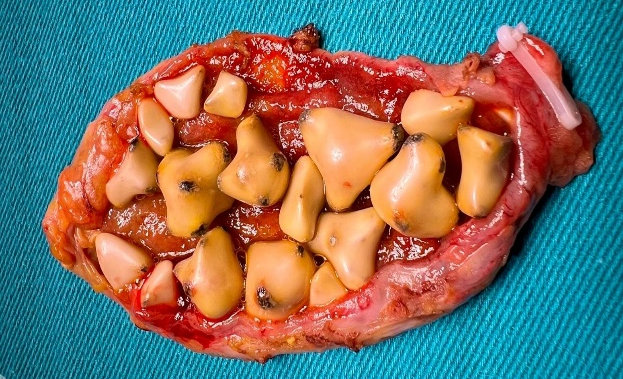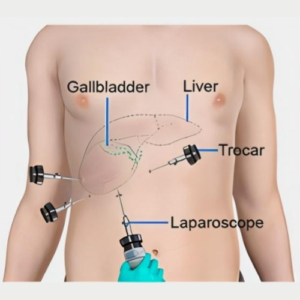

Gallstones or Cholelithiasis are solid deposits that develop in the gall bladder. Size may vary from sand grains to size of pebbles.
Stone formation occurs due to imbalance between cholesterol, bile salts and impaired motility of gall bladder leading to stagnation of bile.


Gallstones may be often asymptomatic but can be symptomatic ranging from mild discomfort to intense pain. The pain is usually seen after fatty rich diet. Other symptoms include nausea, vomiting, gastritis, bloating, jaundice if the bile flow is hampered.
Symptoms can be severe enough when super added infection is there – known as Acute Cholecystitis. Patient may land up in sepsis if the infection is too severe and gall bladder is perforated leading to signs of peritonitis.
Diagnosis usually involves detailed history, physical examination, blood investigations and radiological imaging like ultrasound abdomen – which is cost effective and sensitive to detect gall bladder stones, sometimes CT/MRI may be required in cases presented with jaundice or sepsis.
Treatment depends on the type and day of presentation.
If patient is diagnosed to have cholelithiasis, Laparoscopic Cholecystectomy is the ideal treatment option. Medical management can be tried in asymptomatic small gall stones with Ursodeoxycholic acid, but results are not promising. These patients may ultimately require surgery to prevent complications in future.
Patients presenting with Acute Cholecystitis, treatment depends on the time of presentation and severity of the condition. If presented early, they can be managed with laparoscopic cholecystectomy.
If presented late, they may be initially managed conservatively with IV antibiotics to reduce the inflammation and then posted for Interval Cholecystectomy after 4-8weeks depending on the patient’s condition.


If patient is septic at the time of presentation which is a life-threatening condition, they need to be managed immediately with surgery i.e., Laparotomy (opening abdomen) along with broad spectrum antibiotics and appropriate supportive measures.
In jaundiced patient, immediate decompression of the bile is done through ERCP (Endoscopic Retrograde Cholangio-Pancreaticography) + Stenting of the common channel of the bile duct (CBD- Common Bile Duct), followed by laparoscopic cholecystectomy.
Open Cholecystectomy is an option only in complicated cases with severe infection/ suspicion of underlying cancer.
Gallstones can range from harmless to life-threatening condition, if untreated. Recognising symptoms early and seeking appropriate treatment from experts can prevent unnecessary complications. If you have persistent abdominal pain or any digestive issue, feel free to consult our expert team members at “Vizag Surgicare”.
Mobile No 1 : +91-77029 50513
Mobile No 2 : +91-9848638615
Mobile No 3 : +91-9849239213
First Floor, Mohan Medical Shop, Seethammadhara (NE), Visakhapatnam-530013
info@vizagsurgicare.com
WhatsApp us